|
Over the past few
years, the dung has royally hit the fan when we ran a banner
headline that yells something like:
"RAGLAND WINS
BAJA!"
Our modems emit columns of
smoke, as irritated bikers fire off enraged email messages to us,
proclaiming the fact that a dirt bike, not a stupid truck, was the
overall winner of the event with the fastest time.
Some of these email messages are "not polite" and
tell us just where we can place large objects in body orifices,
because we did not give credit where credit was due.
So this year, the Off-Road.Com staff sat around
and mulled this eternal problem over. If a bike won, we would most
certainly pass this information on to the off-road world, loud and
clear.
However, for a bike to win the
overall this year would prove difficult. You see, every fourth year
or so, SCORE runs the race all the way to near the end of the
peninsula, ending it in La Paz. For 1998, the race would cover a
staggering 1047.4 miles! Normally, the Baja 1000 starts in (or
near) Ensenada, does a big convoluted loop, and ends up back in
Ensenada, some 20 or so hours after the start for the fast
guys.
For slower racers (or those who had
problems), the race would extend well into the better part of two
solid days. This would mean 40 or more hours of trying to finish
this brutal event.
Holding a point to point
race is not only extremely difficult in logistics, it kicks the
actual cost of racing sky-high. A privateer team could enter a Baja
1000 loop race and perhaps complete the event for a few thousand
dollars- on a tight budget. By forcing the racers to go the length
of the Baja peninsula more than doubles the cost.
WHAT IT TAKES TO WIN
In order to win an event of this magnitude, you
cannot even think of racing flat out. Even if you have several
drivers/riders on your team, you have to think about the machine.
When you consider that most off-road racing machines are in need of
a rebuild after a 250 mile race, just imagine what a pounding they
take for over one thousand miles of truly bad road!
It also takes a physical toll.
Which makes what Ivan Ironman Stewart does quite remarkable.
He straps himself in a truck at the start, almost a full day later,
finally loosens the belts and crawls out of the cab.
But think about the motorcycle riders. They
don’t sit down during the race very much, except for those
few smooth sections. And they have to pay attention every inch of
the way. Tag a grapefruit-sized rock with a 21 inch front wheel at
speed, and God knows what will happen. At best, there’s a
horrible jolt through the forks and the bars, the wrists absorb
heavy abuse and the bike lurches around like a safe falling down a
flight of stairs.
At worst, the tire
flattens, the wheel gets caved-in and the bike cartwheels through
the air, tossing the rider off, to land like a sack of sand. And
when this happens at night, the injured rider may not even be able
to find his damaged bike for some time.
When a truck tags a small rock, those huge tires merely grunt
and soak up the hit. Even when a truck nails a huge rock, normally
the result is a simple flat, which can be replaced quickly. Bikes
don’t carry spare wheels.
When a dirt
bike racer gets a flat, he simply rides the lame bike to the pits
with the flat tire, fighting it most of the way. And if the biker
runs those "flat-proof" tires, the bike doesn’t handle quite
like it should.
So what does it take to win
the overall in the Baja 1000 on a dirt bike?
Basically, it takes a strong, simple bike, with proven, tested
components. And it takes a savvy support crew, plenty of
well-placed pits, excellent radio contact and lots of pre-running
before the race.
But more than anything
else, it takes durable riders who know Baja well. Riders who are
smart enough to go just as fast as they need to go to win, but not
so fast that they destroy the bike, or start breaking
things.
Which brings us to Johnny Campbell
and Jimmy Lewis. Riding a Honda factory-sponsored XR-600, they won
the overall and beat Ivan Stewart. Please note that they did not
ride one of the hand-grenade 628 cc missiles beloved by so many,
but instead chose a fairly stock – but well-prepped –
garden-variety XR-600.
Modifications
included a big quick-fill gas tank, factory forks, a special shock,
stout wheels, big-assed lights, a bit of bullet-proofing here and
there and gearing that would let the bike purr along comfortably a
one hundred miles per hour, with something left in reserve.
It’s sad that Johnny and Jimmy did not have
a chance to go head-up against other factories, as Kawasaki has
pulled out of SCORE racing, Yamaha had only a handful of privateers
entered, and apparently, Suzuki has never even heard of the
event.
In fact, the various bike classes
looked more like a Honda parade, than a cross-section of
what’s being ridden out there in the real world.
Still, nothing can detract from the fact that team
J & J did beat every other vehicle on that course, on that
day.
American Honda was proud of the win,
and immediately fired off this press release, which was promptly
ignored by almost the entire media:
SCORE International Baja 1000, Baja, Mexico,
November 14. Everyone knows North America's toughest desert race is
the Baja 1000, but this year maybe they should have renamed the
event the Honda 1000. Honda riders Johnny Campbell and Jimmy Lewis
easily won not only the premier Class 22 motorcycle division, but
the overall race as well, beating the first truck (a factory-backed
Toyota driven by Ivan Stewart) by almost ten minutes! Campbell and
Lewis rode their Honda XR600R to victory in an 18-hour and
58-minute race. The next bike, also a Honda XR600R, was ridden by
Craig Smith and Greg Bringle (19:57:39), while third motorcycle
across the line was another XR600R, piloted by Joel Tarquin and
Eric Brown (22:06:08). In fact, seven out of the top-ten
motorcycles were Hondas.
And in Class 23
ATV racing, the results were largely the same--a Honda sweep of the
first three spots. The new Honda FourTrax 400EX, ridden by Dennis
Cox and Denny Wolf, easily scored victory as the first all-terrain
vehicle across the line (23:59:33), and in the overall
motorcycle/ATV results ranked eighth. All-in-all, another stellar
Honda weekend!
At least it made for good copy.
But an interesting story happened right behind the
race winning bike team, and very few people know about it. The
"other" Honda team was only a few minutes behind J & J at the
San Quintin/Santa Maria area (about one-fourth of the way into the
race), and running hard.
They dropped a few
more minutes before Kilometer 100, and even a few more by Catavina.
Before Punta Prieta, they were down around 23 minutes physically.
Somewhere near, El Arco (over 500 miles into the race), the bike
had a suspension linkage problem, which also wasted the shock and
airbox. They had a 55 minute pit along Highway 1 to make repairs,
and still finished second bike, an hour behind J & J.
As soon as Honda heard that the other bike was in
the pits, Campbell and Lewis got instructions to take it easy, and
rode a smart race to win.
An interesting
note about the winning bike: since it was a basically stock XR 600
motor, with only a cam, minor head work, oil cooler, and standard
FMF pipe, maybe that's the reason they got passed by some guy on a
BMW R1100 GS on the highway above San lgnacio. The BMW riding
spectator said he was cruising at about 115 miles per hour and blew
by the first overall bike.
UNSUNG
BIKE HEROES
Tony Tellier, our
roving ORC ace, told us about two incidents that point out
something about how tough mentally and physically dirt bike racers
really are:
"After a leisurely 5 day
pre-run of the recent Baja 1000 with 11 of my closest friends, we
made our way to a beautiful bay on the west side of the peninsula,
where the race course passes just a few yards from the emerald
waters of the subtropical pacific ocean.
We
picked out a location with a lovely view of the water and proceeded
to do what we do. We set up a full service pit complete with all
the stuff one would expect to find in a full service pit, but with
one addition. The five Burmashave signs laid out in the mile or so
preceding our two day home, invited any racer to stop in for Hot
Coffee, Nuts & Bolts, Oil & water, welding, and last but
not least, a huge banner declaring We Fix Stuff Free!
I'll tell anyone who cares to listen that 700
miles into the Baja 1000, you see a lot men and equipment who have
been put to the test and even more who are at the breaking
point.
We were scheduled to gas 19 bikes, 2
quads and a Class 7 truck, and for the most part, our scheduled
charges went off without a hitch. We did, however, have two guests
worthy of special note.
At 3:25 AM Friday
morning, a motorcycle rider stopped at the edge of our pit and
asked how much for a cup of coffee? I had just woken up to start my
shift and had two fresh pots brewing. I informed the rider that the
coffee was free, but was not ready yet and he said that was OK,
he'd wait.
Odd, I thought, for a guy in a
race to wait for a cup of coffee, but we helped him from his mount
to a seat by the fire. The man was freezing and his gaze was fixed
off in the distance. He looked terrible. I deduced by his race
number that he was in his late 40s. His hands were cramped like an
arthritic geriatric and his eyes were puffy like a guy on a
four-day drunk.
I asked him if he was OK?
He replied in a scratchy monotone voice: " I'm tired." Before the
coffee was done perking, he was dosing by the fire. One of the guys
was just getting him some fresh java when a Class 8 stopped in with
no brakes. We spotted a broken rear break line, and while we were
fashioning a repair, our guest arose from his place by the fire and
headed for his bike.
As he was leaving, I
shouted to him my standard question." What mile did you get on
at?"
He made a slow turn toward me and
responded "mile 0". We all paused for a moment from our task to
watch our super guest mount up and ride off into the night.
Just before dawn, we began to get reports of a
rider who had cartwheeled in the silt beds some 50 miles to the
north of us. In no time, the radio rumor mill had the guy in the
chopper on his way to San lgnacio. Word had it he was bleeding
badly from a head injury, he supposedly had a couple of broken
ribs, a possible broken leg and multiple minor injures.
Two or three hours later, a bike pulls into our
pit. It's one of our riders, and he comes to a stop and falls over
with the bike on top of his leg. The guys race over, lift the bike
off of him and sit him up. It's the human canon ball; he is a
Japanese guy, maybe 135 pounds soaking wet. He's covered in his own
blood. One of his fingers is sticking out at 45 degrees to his
hand. He's holding his ribs, it looks like he has a broken leg; he
can barely stand.
One of our guys is an EMT
and he sets the guy’s finger and puts a splint on it. He
takes a drink of water, and the crew tries to talk him into
staying, but he speaks no English. He keeps pointing to a wristband
that has the number 16 on it. We are the 14th pit in a chain of 20
pits set 50 miles apart.
The rider's
wristband indicates he is supposed to get off at number 16,
100 miles down course. He refuses to stay. One of
his friends is there waiting for the bike. One of the guys starts
his bike for him, but the rider can't swing his broken leg over the
seat, so the guys get him a milk crate and he is the most grateful
man in the world.
He situates his twisted
carcass atop the bike as the crew holds him up and off he goes into
the post dawn dust.
Two and a half hours
later, we hear a radio relay say that the Japanese rider made his
pit, got off the bike, sat down and passed out cold right
there.
THE GLORY OF SECOND
OVERALL!
No matter that the bike
turned the fastest overall time at the Baja Classic, nothing can
take away from what Ivan Stewart accomplished. Driving solo, he
finally got the one major victory that had been eluding him for two
decades plus.
The 25 year quest was
realized for the "Ironman", as he crossed the finish line of the
1998 Baja 1000. While no stranger to the winner’s circle of
Baja's 1000 wins, a win at the "point to point" La Paz run had
somehow managed to elude him.
This
certainly took care of that little detail. Before the race, Ivan
stared wistfully into a TV camera and said, "Just once, I’d
like to win the traditional Baja 1000 to La Paz."
After the race, The Ironman was all smiles,
knowing the missing link was now in place.
And what a record he has to show! Consider: this was the
61st major race win in his 27 year career. In addition
to winning three overall Baja 100 races, he has also nailed down 13
Baja 500 events!
With his PPI-prepped
Toyota Trophy Truck tuned to perfection, Ivan left the starting
line in Santo Thomas at the crack of 9 am - the first truck off the
line – sounding more like a Pro-stock drag racer, than an
off-road racer. With a dust free course and clear skies in front of
him – Ivan drew the number one starting position - the stage
was set for the "old man" of desert racing to bring home the most
coveted trophy the sport has to offer.
Two
positions back, sat "Lightning" Larry Ragland, in the White
Lightning Chevy. For the last three years, Ragland has dominated
the 1000, and was all too ready to repeat the experience at
Stewart's expense.
Multiple pre-runs had
left Ragland with a keen familiarity with the long course, leaving
many to conclude (and rightly so) that the final battle would come
down to a Stewart/Ragland showdown.
As the
race developed, Stewart set a fast pace, pulling over five minutes
on Ragland, who had difficulties getting around Dave Ashley in the
Duralast/Ford Trophy Truck.
By pit 1,
Stewart radioed in asking for time splits between the trucks and
commented: "It's running great! I can hold this pace all
day".
By mile 300, however, fortunes
changed, and Ragland was quickly gaining ground, as Ivan reported a
coolant temperature rise, a potentially race ending problem, if not
resolved. With a close eye on the gauge, Stewart carried on, and
Ragland continued to close the gap.
By
"Splash 2" (a quick pit for fuel and light installation), the
problem had seemingly cured itself, and with minimal time lost in
the pits, Stewart was quickly on his way.
Quite often, perfectly sound vehicles will start running hot
when they’re in a "trailing wind" situation, that is, with a
stiff breeze behind them, which slows the flow of air down through
the radiator. Once pointed into a normal breeze, everything returns
to normal.
Moments later, Ragland flashed
by the pits in hot pursuit of the Ironman, who was now sporting his
rack of night lights. Darkness quickly was approaching and the
terrain began to turn hostile. At night, racers charge through a
tunnel created by their lights, and veering off the marked and
beaten course, even by a few feet, can spell disaster.
Within 100 miles, Stewart wasted a tire,
sidelining the Toyota for a semi-quick tire change. Being a solo
driver, Stewart worked alone to repair the limping truck, and could
only watch as Ragland closed the gap and built a lead of his
own.
Once ahead, Ragland cranked up the
throttle to put as much lead as possible on Stewart, during his
downtime. Unfortunately the move backfired, as Larry lost control
of his big Chevy on a corner and took up the environmentally
correct practice of "Tree Hugging." The tree won, and Larry came in
a distant second in that skirmish. Larry’s truck was beat up
and ugly from the encounter, but structurally sound.
Ivan, now re-tired, regained the lead and then
some as Ragland and company extracted the big Chevy from it's leafy
bondage
With darkness over the peninsula,
and Hella HID's lighting the way, Stewart continued putting
distance on Ragland and the increasingly smaller field.
Continued
|
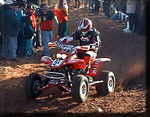
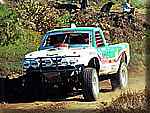
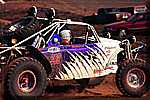
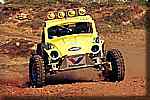
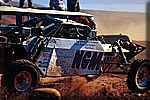
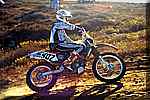

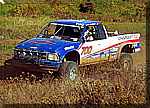
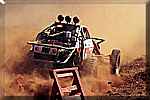
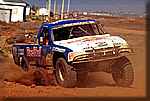

 Your Privacy Choices
Your Privacy Choices